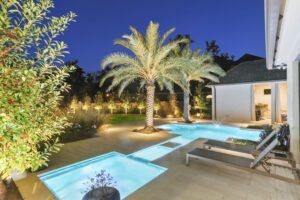South Coast Casual – The latest beachfront getaway for Carroll and Dale Mathews reflects their family’s easygoing lifestyle
Sitting on the screened porch looking out at the gently lapping Gulf waves, it’s almost easy to forget that there ever was such a thing as a cruel storm called Katrina.
Carroll and Dale Mathews can’t forget, though. The Baton Rouge residents saw the 20-year-old beach house they had built in Pass Christian wiped away by the hurricane that blew through seven years ago this month.
But every lazy afternoon spent reading a book on a porch swing just yards away from the sand pushes those terrible moments further into the past. Today, the Mathewses’ newfound getaway is as idyllic as their old house ever was, welcoming yet another generation of family members to make their own special memories with toes in the sand or head on a hammock.
Despite being firmly rooted in Louisiana’s capital city—Carroll taught interior design at LSU for more than 30 years, and Dale founded The Backpacker outdoor outfitter shop—the Mathewses have always felt a pull to Mississippi’s sandy coast. You could say it was in their blood: Members of Dale’s family were some of the founding residents of nearby Gulfport, and Carroll’s family had been regularly visiting this area from New Orleans since the 1880s.
Both Carroll and Dale had spent many happy childhood days on the beaches of south Mississippi, so when the couple decided to build their own beach house in 1984, they knew just where to dig into the sand. Their second home was planted right next to Carroll’s parents’ family beach house. “We were attracted to the fact that we could be near family, plus such close proximity to Baton Rouge gave us an easy weekend trip,” says Dale.
The family, including sons Austin and Michael and daughter Katherine, made the two-hour drive many times over the years. Carroll fondly recalls the casual appeal of the beach house, with its “huge porches” and “three hammocks everybody fought over.” “Fans were everywhere, so we could let the house stay open and let the Gulf breezes blow through,” she says. “About a third of the total square footage was porches, which was where we spent most of our time.”
While on the coast, the naturally active family made the most of their location by swimming, sailing, fishing and windsurfing. “I’ve been a windsurfer for years, and Pass Christian offers some of the best conditions close to Baton Rouge,” Dale says.
Then came Katrina, making the family wonder if the days of breezy beach life were in the past. Carroll, Dale and Michael drove down to “the Pass” early in the morning on the day after the hurricane, parking about three miles from their property and walking down the beach to discover that the house had been “completely blown away,” says Dale.
Only a single pier remained from the house, and the family’s old tire swing still hung by a thread from one of the few surviving trees. “We had essentially lost everything,” Dale says.
In the months after the storm, the family again made many trips here, this time to clear the land and try to save some of the “wonderful trees.” But eventually they concluded that with some 250 trees lost on their property, the landscape would never be the same. At the same time, Pass Christian’s leaders announced a new Smart Code Plan designating the Mathewses’ part of town for multifamily target projects. Realizing that their 4.5-acre tract would indeed be ideal for a large complex, the family decided it was time to make a change. They needed to find out “whether we really wanted to come back to Pass Christian or go somewhere else,” says Dale.
Eighteen months after the storm, the couple took two weeks to travel the coast from Bay St. Louis to Panama City, stopping in charming town after town and talking with real estate agents. They compared prices, beaches and attractions.
“Then we met with our children and asked them their opinions,” Dale says. “They all wanted to return to Pass Christian.”
It didn’t take long for Dale and Carroll to agree that the Pass was in fact the right place for the family to lay down roots again. The shorter distance from Baton Rouge made it an easier weekend trip than, say, Gulf Shores or Destin and a convenient destination for guests. The town was still among the coast’s best for fishing, sailing and windsurfing. And the mainly residential makeup of the Pass, which some call “the Hamptons of the South,” gave it a quiet charm that could not be duplicated elsewhere.
But perhaps the most significant factor in the family’s decision was something more intangible: memories of carefree days at sailing camp and weekends spent relaxing on those old screened-porch hammocks.
So the search began for another house on their old stomping ground. Carroll and Dale initially dismissed the Georgian-style brick home on East Scenic Drive, believing it to be too formal for their lifestyle and lacking essential elements like porches. But the formal design actually proved to be a blessing, as Carroll realized that the large windows across the front could easily be transformed into doorways leading to new porches. And with its location on one of the highest elevations on the beach, this house had only taken on about a foot and a half of water, even in Katrina’s 30-foot-plus tidal surge. Such a position would not only make restoration easier but would also offer an excellent vantage point for enjoying the Gulf view.
Once the home was theirs, the Mathewses first set about making Carroll’s open-door concept a reality. With help from Baton Rouge architect Chuck Oliver, they also added three large porches: a wraparound screened porch on the first floor, a second-floor open porch with a small sun deck, and a large screened sleeping porch upstairs, “which we always wanted,” says Carroll.
“The porches really changed the entire structure into a beach house,” says Dale. “They are where we spend all of our time. We play games, read books, work some great jigsaw puzzles and dine on the porch. And, of course, we just enjoy the view of the beach and Gulf.”
Indoors, the couple opened walls and expanded doorways between rooms, making the space more flexible and less formal. The foyer, which Carroll says had been “large and grand,” was given a smaller scale with the addition of a catwalk from the landing to the new upstairs porches. Carroll, who had retired from LSU in 2006 with hopes of spending more time concentrating on artwork, also painted a large mural in the entryway, giving the area an apropos tropical feel.
Like many of the beachfront homes in Pass Christian, the new house has an expansive, grassy lawn shaded by old live oaks. “This really keeps the heat down,” Dale says. “We didn’t want to have to spend all of our time locked up inside an air-conditioned building sitting on hot sand.”
To the existing landscape, Dale added six palm trees to give a Caribbean feel; three provide shade on the sandy beach itself. “When you’re sitting under them on the sand and you hear the rush of the fronds, it really sounds like you could be sitting on a deserted beach somewhere,” he says.
Now that both Dale and Carroll are retired—Dale handed over the reins of The Backpacker to son Michael in 2006—they are able to travel to the beach house more often. Members of their large extended family are also frequent guests. Young grandchildren are now beginning to enjoy the same aquatic pastimes the Mathews kids did not so long ago, and guests of all ages are spending their nights on the sleeping porch with the Gulf breezes keeping them comfortable.
There are no regrets about the family’s decision to return to the Pass. Every time 4-year-old grandson Garrett climbs onto the tire swing out front—the same one his father pulled out of a tree in the aftermath of Hurricane Katrina—the family is reminded not only that everything can change in an instant but also that, happily, some things never really change at all.











